Stony Brook Medicine doctor honored for water rescue in Hampton Bays
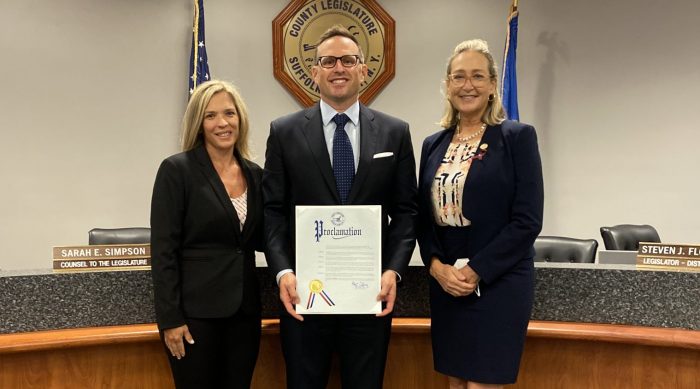

According to the American Cancer Society, an estimated one in eight men will be diagnosed with prostate cancer in their lifetimes. Until now, conventional imaging, especially at low PSA (Prostate-Specific Antigen) levels, has not been able to identify the location and extent of the disease in the majority of cases of men with a suspected cancer recurrence. Now, Stony Brook University Cancer Center, in conjunction with Stony Brook Advanced Imaging, is the first on Long Island to offer men with prostate cancer targeted Positron Emission Tomography (PET) imaging with PYLARIFY® (piflufolastat F 18) Injection, a Prostate-Specific Membrane Antigen (PSMA) imaging agent.
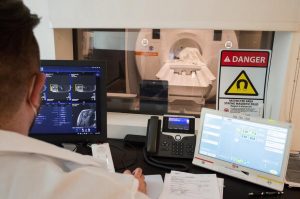
Backed by the experts and state-of-the-art technology at Stony Brook Advanced Imaging Center, this type of imaging enables visualization of lymph nodes, bone and soft tissue metastasis to determine the presence or absence of recurrent and/or metastatic prostate cancer.
Dr. Dinko Franceschi, Chief of Nuclear Medicine and Director of Clinical PET in the Department of Radiology at the Renaissance School of Medicine, states, “For years, there has not been good imaging modalities for prostate cancer – now we have this tool to see exactly where the tumor is in a patient, which will help in determining the best approach going forward.”
Developed by Lantheus, PYLARIFY® was recently approved by the U.S. Food and Drug Administration (May 2021) as the first commercially available PSMA PET imaging agent for prostate cancer. Those with suspected metastasis who are candidates for initial definitive therapy or those with suspected recurrence based on elevated serum PSA level are eligible for the scan.
PSMA scans are available at two Stony Brook Medicine imaging centers (Riverhead and Stony Brook) with more locations to follow.
For more information or to make an appointment, visit imaging.stonybrookmedicine.edu
About Stony Brook Medicine:
Stony Brook Medicine integrates and elevates all of Stony Brook University’s health-related initiatives: education, research and patient care. It includes five Health Sciences schools — Dental Medicine, Health Technology and Management, Medicine, Nursing and Social Welfare — as well as Stony Brook University Hospital, Stony Brook Southampton Hospital, Stony Brook Eastern Long Island Hospital, Stony Brook Children’s Hospital and more than 200 community-based healthcare settings throughout Suffolk County. To learn more, visit www.stonybrookmedicine.edu.
About PYLARIFY®
PYLARIFY® (piflufolastat F 18) injection s a fluorinated small molecule PSMA-targeted PET imaging agent that enables visualization of lymph nodes, bone and soft tissue metastases to determine the presence or absence of recurrent and/or metastatic prostate cancer. For men with prostate cancer, PYLARIFY PET combines the accuracy of PET imaging, the precision of PSMA targeting and the clarity of an F 18 radioisotope5 for superior diagnostic performance. The recommended PYLARIFY dose is 333 MBq (9 mCi) with an acceptable range of 296 MBq to 370 MBq (8 mCi to 10 mCi), administered as a bolus intravenous injection.
As we continue to battle against the coronavirus and approach flu season, it’s imperative that we know the facts about the vax. This Tuesday, August 17, join experts from Stony Brook Medicine as they discuss the importance of and science behind vaccines during a LIVE virtual event. Our experts will dispel misconceptions and address concerns surrounding key vaccinations, including those for COVID-19, the flu, and human papillomavirus (HPV).
The ongoing pandemic has created unprecedented challenges for healthcare providers and patients. A recent study showed a 71% drop in healthcare visits for 7 to 17-year-olds, when critical vaccines like Tdap, HPV, and meningitis are given. The HPV vaccine is recommended for boys and girls at age 11 or 12 because it works best when given before exposure to HPV. It can be given as early as age nine, and through age 26 for both men and women, if they did not get vaccinated when they were younger. The vaccine is safe with more than 270 million doses having been given worldwide since 2006. Even though the HPV vaccine can prevent many cancers caused by HPV infection, nearly half of adolescents in New York State are not getting the vaccine as recommended.
Every year in New York, nearly 2,600 people are diagnosed with cancer caused by HPV. To help educate those across Long Island about the importance of HPV vaccination for cancer prevention in adolescents, the Stony Brook University Cancer Center received a grant funded by the New York State Department of Health and Health Research Inc. This allows Stony Brook, the first and only institution on Long Island to be part of the Cancer Prevention in Action (CPIA) program, an opportunity to further promote the importance of the HPV vaccine as cancer prevention.
WHEN:
Tuesday, August 17, 2021 at Noon EST
The livestream event can be seen on:
Facebook at https://www.facebook.com/
Or
Youtube at https://www.youtube.com/watch?
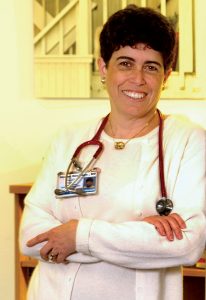
MODERATOR:
Sharon Nachman, MD, Professor of Pediatrics and Associate Dean for Research at the Renaissance School of Medicine, Stony Brook University & Chief of the Division of Pediatric Infectious Diseases, Stony Brook Children’s Hospital
PANELISTS:
Jill Cioffi, MD, FAAP, Assistant Professor of Clinical Pediatrics at the Renaissance School of Medicine, Stony Brook University and Medical Director of Ambulatory Primary Care Pediatrics, Stony Brook Children’s Hospital
Lauren Ng, DO, FAAP, Assistant Professor of Pediatrics at the Renaissance School of Medicine, Stony Brook University and Primary Care Pediatrics, Stony Brook Children’s Hospital
For more information on Stony Brook Medicine’s vaccine program visit, https://www.
This program is supported with funding from the State of New York. The views expressed in this educational event and by speakers and moderators do not necessarily reflect the official policies of the State.
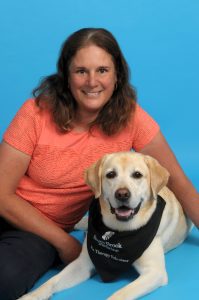
Molly came to Stony Brook with an already impressive resume. She is certified by Therapy Dogs International (TDI) and is recognized by the American Kennel Club (AKC) as a Therapy Dog (THD) for her work over the past several years. Besides her visits at Stony Brook University Hospital, Molly is a reading companion for children at a library. Molly is also highly skilled in scent detection. She competes in events that showcase skills similar to bomb or narcotics detection and is currently trialing at the elite level with the National Association of Canine Scent Work (NACSW). Through AKC, Molly earned obedience titles Beginner Novice (BN) and Companion Dog (CD); and has one leg on her Companion Dog Excellent (CDX) title. AKC has also awarded her the Trick Dog Advanced (TDA), Canine Good Citizen (CGC), AKC Temperament Test (ATT) and Farm Dog Certified (FDC) titles.
Before the pandemic, Doreen and Molly engaged in hospital visits primarily involving Stony Brook’s geriatric patients. Regular visits were arranged by Carolyn O’Neill, NICHE (Nurses Improving Care for Healthsystem Elders), Elder Life Coordinator and Geriatric Educator at Stony Brook Medicine.
“I have heard countless stories on how visits from Molly and Doreen have greatly benefited our patients,” says O’Neill. “Molly has brought so much cheer to those who need it and she has touched the hearts of many at Stony Brook.” Doreen recalls one patient who had a profound reaction to one of Molly’s visits. After having a stroke, a woman would not talk to anyone. That was until Molly came to see her. After the four-legged volunteer left, the patient’s nurse asked, “What did you think of Molly?” The patient responded, “I love that dog!”

When COVID-19 suspended Volunteer services and in-person visits, Pia York, Therapeutic Intervention Coordinator at Stony Brook Medicine, took the lead to bring virtual Pet Therapy visits to staff. Rounding with an iPad, Pia with help from recreation therapists Chris Brigante, Diane Dignon and Casey Carrick, visited various units bringing tale wags, virtual kisses and tricks to help relieve the stress. They virtually visited every area of the hospital from the pharmacy on the first floor to the 19th floor.
During these visits, Molly became a celebrity. Her name was mentioned hospital-wide and requests for visits increased ten-fold. In addition to visits, Doreen and Molly creatively used photos to help emphasize the importance of social distancing, proper mask wearing, and hand washing to name a few. Some were even written in Spanish. The photos also contained various inspirational messages for Stony Brook staff as they worked tirelessly to care for patients during the height of the pandemic.
Doreen says she simply wants to share the special joy Molly brings. “She always puts a smile on my face and makes me laugh. Patients and staff would often say that Molly made their day,” says Doreen. “When the COVID crisis hit, I thought about the enormous stress and uncertainty at the hospital. Continuing our visits remotely to raise spirits was the least I could do.”
Molly is also a bit of a celebrity outside of Stony Brook. She can be seen running with a little girl at the end of the current Primatene Mist commercial.
To learn more about Pet Therapy at Stony Brook Medicine, visit https://www.
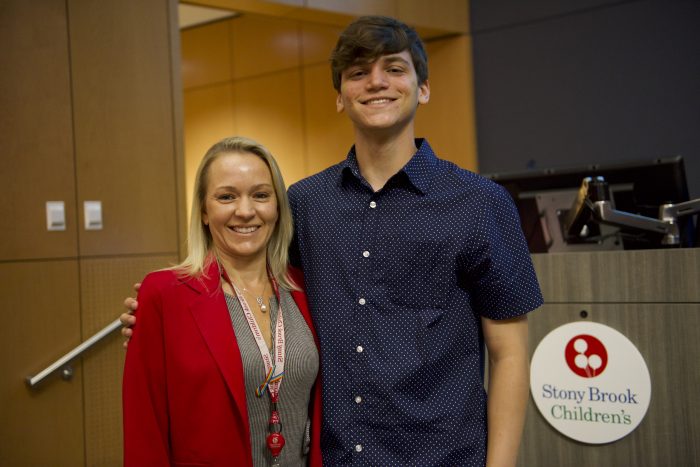
Stony Brook Children’s Hospital gathered doctors, nurses, physicians and staff to celebrate their 10th anniversary of pediatric care this Tuesday, both in person and virtually.
Throughout the years, SBCH has provided innovative research, clinical trials and breakthrough techniques to benefit pediatric patients. The hospital has more than 180 skilled pediatric specialists who cover more than 30 specialties.
“We have a long history of caring for children, and it was with the generational knowledge and passion that we made the commitment to create an institution that would better meet the needs of nearly half-a-million children in Suffolk County,” said Maurie McInnis, president of Stony Brook University.
Even during the pandemic, SBCH had pediatric investigators on duty, researching the effectiveness the COVID-19 vaccine has on children.
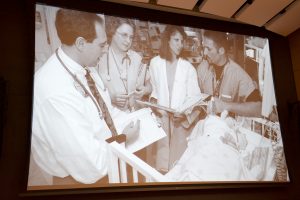
Holbrook high schooler Reese Tiller attended the event and shared his experience with the children’s hospital that helped treat him when he had a cancer diagnosis.
After a soccer accident left Tiller with a concussion, it was SBCH who found out through testing that he had a large mass on his chest which was discovered to be leukemia.
“I was extremely confident that Reese was in the best place and was only going to get the best care possible,” said his mother Jaimi Tiller.
The Tiller family expressed their gratitude for SBCH and the effort it put into curing Reese’s illness. The hospital kept the family, including Reese, informed on every update possible.
“The second I got there, I felt loved and cared for,” Reese said.
The transition to the children’s hospital was easy for the Tiller family and despite being there for treatment, the overall feeling of the hospital was welcoming for all.
SBCH has become a vital part of the academic and clinical mission of SBU and Stony Brook Medicine, which aim to provide the highest quality of education and training.
With the dedication and passion of Stony Brook’s health care workers, SBCH has become a regional and national leader in children’s health care, and the first children’s hospital in the nation that created a center for the treatment of pediatric multiple sclerosis.
“You should all be proud of the outstanding clinical quality and breadth of services Stony Brook Children’s provides,” said Dr. Margaret McGovern, vice president for Clinical Programs and Strategy for SBM. “For me personally, it has been an honor to work with all of you and see your dedication and passion for improving children’s lives has been a daily inspiration.”
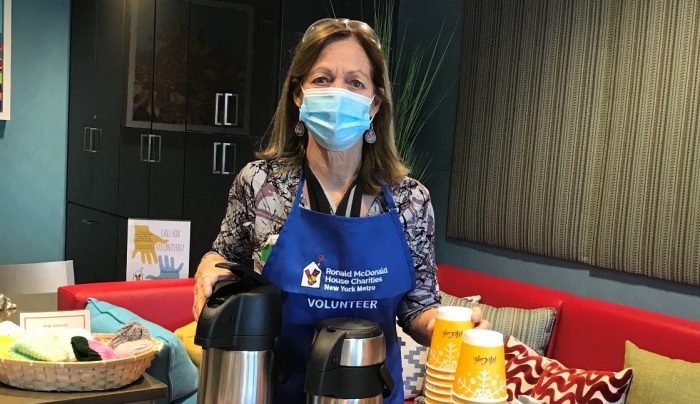
The Ronald McDonald Family Room — a part of Stony Brook Children’s Hospital — has served as a sanctuary for parents and family members who have a child that is in prolonged care of the facility.
Officially opening in 2013, the purpose of the family room is to provide a respite space for parents to spend their downtime while their child is being treated in the hospital, whether that be long or short term.
However, since the pandemic began, the lounge promptly shut down and is currently awaiting the green light from the hospital to reopen.
“It is sad because it shut down a great resource room,” said Tricia Telemaque, host and board member of the family room. “When we open really depends on the day-to-day and what happens with COVID. However, we are on alert and ready to go back full force.”
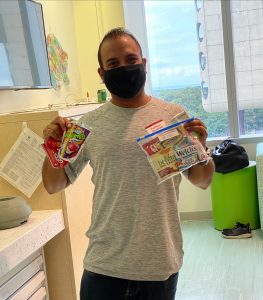
The lounge emulates an apartment-style environment with countless amenities for family members such as a fully stocked kitchen, private showers and laundry machines.
Pre-pandemic, volunteers would solicit the community to have restaurants, pizza places and bigger chains such as Chick-fil-A and McDonald’s deliver food that the volunteers would serve to the families of the sick children. The lounge offered breakfast, lunch and dinner.
Providing emotional support for families is another key aspect of the volunteer work. Having a person to talk to could serve as a stress reliever for the unfortunate circumstances going on in a parent’s life.
“I remember one day I was sitting in the room and this one woman was folding her laundry and she asked, ‘Could I just sit and talk to you because talking to someone while folding laundry feels normal’ so it really is more of a solace room,” Telemaque said.
According to her, the children admitted in the hospital also have siblings who come to the lounge and are often forgotten about. The volunteers make sure there are plenty of books and toys to play with, not only for the child admitted but for their siblings too.
“The intent is to not have any white coats [doctors] in the lounge,” Telemaque said. “So, it’s not a place where doctors and nurses can come in.”
One of the biggest goals for Ronald McDonald House Charities is to bring awareness to Long Islanders about what the lounge is and its purpose for the families that use it.
Since the pandemic began, the organization has continued to work hard for families who were suffering through the COVID period. However, donations of food have become more complicated due to the need to have items individually wrapped such as chips and granola bars.
The family room relies fully on donations from the surrounding community and businesses, as it serves approximately 3,600 families a year, so fundraising is essential for their need to remain active.
“When I started working in the room, I was amazed at how few of my friends knew that there was a Ronald McDonald [room] here in Stony Brook,” Telemaque said. “So simple awareness that there is such a need for something like this is very important and I think that is an underserved opportunity.”

Among many parents who have used the family room, Karen Maher said using the room has been a huge stress reliever on both her and her daughter, who is undergoing cancer treatment.
“I look at the Ronald McDonald House as a blessing,” Maher said. “They really helped my daughter’s treatment go much easier for me and her. They’d bring little gifts for her too, something as simple as a teddy or a blankie.”
With the help of the lounge and their conveniences, Maher was finally able to get the rest and relaxation she needed.
For more information on how to donate to the Ronald McDonald Family Room in Stony Brook Children’s Hospital, visit www.rmhcnym.org or call 516-775-5683.
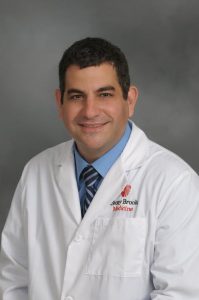
Now that temperatures are on the rise and humidity is surging , it is important to protect our hearts from the hazards of the summer sun. On Chen, MD, interventional cardiologist and Director of the CCU and Telemetry Units, Outpatient Cardiology Services and the Lipid Program at Stony Brook Medicine, has some suggestions to help you stay heart-safe all summer long.
People with an existing heart condition need to be careful with warmer temperatures, but even a healthy heart can be put under stress when temperatures climb. Following are tips for helping to make your summer heart-safe:
Hydrate. Adequate hydration is nothing less than your best friend as the summer heat moves in. Drinking plenty of water helps regulate your temperature, helps your heart pump more easily and keeps all your organs functioning properly. Remember to drink before you are thirsty, and avoid alcohol and caffeinated beverages, which can dehydrate the body. And, it is important to know that some common heart medications can make you more vulnerable to high heat and increase your hydration needs. Talk to your doctor about your specific hydration needs.
Staying Cool. If you don’t have access to air conditioning, cold compresses (an ice-pack or ice-water filled bottle) applied to your ‘pulse points’ — the areas where your veins are closest to your skin’s surface, including wrists, neck, temples and armpits — can help you cool down.
Eat Water-Rich Foods. You get about 20 percent of your water from the foods you eat. A hot weather diet that emphasizes cold soups, salads and fruits can both satisfy hunger and provide extra fluid. Strawberries, watermelon, peaches, cucumbers, celery, tomatoes, peppers and spinach, are all fruits and veggies that are 90 percent or more water.
Know Heat Illness Warning Signs. Spending too much time in extreme heat may lead to heat exhaustion and, in turn, heatstroke, two serious heat-related illnesses in which your body can’t control its temperature.
Heat Exhaustion Symptoms: Heavy sweating, nausea or vomiting, muscle cramps, tiredness, dizziness and fainting. Treatment: Move to a cool place, loosen clothing, use cold compresses, sip cool (not cold) water. If symptoms persist, call 911.
Heatstroke (also called Sunstroke) Symptoms: Fever of 104 degrees or more; severe headache; behavioral changes; confusion; hot, red skin; no sweating; rapid heartbeat and loss of consciousness. Treatment: Heatstroke is a life-threatening medical emergency. Call 911 immediately. Quickly move the individual to a cooler place, use cold compresses, do not give anything to drink.
Know Your Numbers. See your doctor to get a careful look at your “numbers,” including your cholesterol and triglyceride levels, your blood pressure and more. Knowing your numbers and your risk factors are an important part of heart health, especially before engaging in warm-weather activities.
Timing is Everything. Avoid being outdoors during the hottest times of the day, when the sun is at its strongest and temps are at their highest. Your cardiovascular system has to work harder on a hot day in an effort to keep your body cool. In fact, for every degree that your body temperature rises, your heart has to pump an additional ten beats per minute. Everyone is at risk in extreme heat, but high temperatures and humidity are particularly stressful for those who already have a weakened heart.
Be Sun Savvy. A sunburn can dehydrate you and impede your body’s ability to cool. If you’re going to be outside during the peak sun of the day, be sure to apply sunscreen 30 minutes before you head out. Reapply every couple of hours.
Dress for Sun-cess. Think loose, light-colored clothing (to help reflect heat) that is made of a lightweight, breathable fabric like cotton. Add well-ventilated shoes, a wide-brimmed hat, shades and sunscreen and you’re good to go.
Pace Yourself. Make your warm weather workouts shorter and slower, aim for morning or evening when the temps and humidity are lower, choose shady pathways and trails or an air-conditioned space. Work with your healthcare team to develop a plan that is best for you.
Listen to your body. If you aren’t used to regular exercise, are over 50, have heart disease or have questions about your heart health, see your doctor before participating in any strenuous outdoor summer activities.
Although anyone can be affected by heat illness, people with heart disease are at greater risk.
For more information, visit www.heart.stonybrookmedicine.
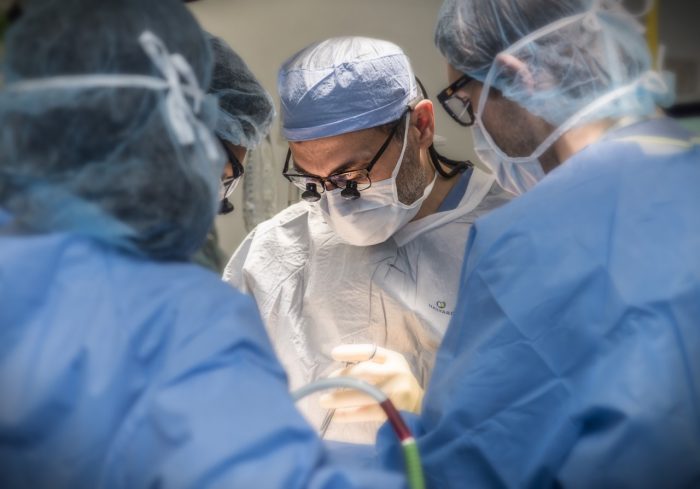
The Cardiothoracic Surgery Division at Stony Brook University Heart Institute has earned a distinguished three-star rating from The Society of Thoracic Surgeons (STS) for its patient care and outcomes in isolated coronary artery bypass grafting (CABG) procedures in 2020. The three-star rating, which denotes the highest category of quality, places Stony Brook University Hospital among the elite for heart bypass surgery in the United States and Canada. The Stony Brook Heart Institute received two back-to-back three-star ratings from The Society of Thoracic Surgeons (STS) in 2017 and 2018, and now an overall three-star rating for 2020.
“This elite rating is reflective of our entire organization’s commitment to quality and safety — from preoperative planning to thorough coordination among multidisciplinary team members — for the optimal outcome for the patient receiving cardiac care,” says Margaret McGovern, MD, PhD, Dean for Clinical Affairs and Vice President, Health System Clinical Programs.
“At Stony Brook, we take great pride in our comprehensive heart program that has a long legacy of bringing the highest quality standards to benefit our patients and their families,” says Carol Gomes, Chief Executive Office, Stony Brook University Hospital. “And we remain laser-focused on serving our community with the most advanced technology, our outstanding cardiovascular staff and the full spectrum of lifesaving cardiac interventions.”
“The three-star rating is a testament to our team’s deep commitment to bringing the best in cardiac care to our community,” says Henry J. Tannous, MD, Co-Director of the Heart Institute, Chief of Cardiothoracic Surgery and General T.F. Cheng Chair, Cardiothoracic Surgery, Renaissance School of Medicine at Stony Brook University. “Patients can have peace of mind knowing they’re getting care from one of the top-rated facilities in the nation.”
The STS star rating system is one of the most sophisticated and highly regarded overall measures of quality in health care, rating the benchmarked outcomes of cardiothoracic surgery programs across the United States and Canada. The star rating is calculated using a combination of quality measures for specific procedures performed by an STS Adult Cardiac Surgery Database participant. For 2020, 6.1% of participants received the three-star rating for isolated CABG surgery.
“The Society of Thoracic Surgeons congratulates STS National Database participants who have received three-star ratings,” said David M. Shahian, MD, chair of the Task Force on Quality Measurement. “Participation in the Database and public reporting demonstrates a commitment to quality improvement in health care delivery and helps provide patients and their families with meaningful information to help them make informed decisions about health care.”
The STS National Database was established in 1989 as an initiative for quality improvement and patient safety among cardiothoracic surgeons. The Database includes four components: the Adult Cardiac Surgery Database (ACSD), the Congenital Heart Surgery Database (CHSD), the General Thoracic Surgery Database (GTSD), and the mechanical circulatory support database (Intermacs). The STS ACSD houses approximately 7.4 million surgical records and gathers information from more than 3,500 participating physicians, including surgeons and anesthesiologists from more than 90% of groups that perform heart surgery in the US. STS public reporting online enables STS ACSD participants to voluntarily report to each other and the public their heart surgery scores and star ratings.
“The STS rating is based on the Division of Cardiothoracic Surgery’s experience in coronary artery bypass grafting (CABG) surgery, and we believe that the quality and expertise illustrated by the top rating is reflective of the entire Heart Institute’s dedication to excellence in patient care,” says Dr. Tannous.
About Stony Brook University Heart Institute:
Stony Brook University Heart Institute is located within Stony Brook University Hospital as part of Long Island’s premier university-based medical center. The Heart Institute offers a comprehensive, multidisciplinary program for the prevention, diagnosis and treatment of cardiovascular disease. The staff includes full-time and community-based, board-certified cardiologists and cardiothoracic surgeons, as well as specially trained anesthesiologists, nurses, physician assistants, nurse practitioners, respiratory therapists, surgical technologists, perfusionists, and other support staff. Their combined expertise provides state-of-the-art interventional and surgical capabilities in 24-hour cardiac catheterization labs and surgical suites. And while the Heart Institute clinical staff offers the latest advances in medicine, its physician-scientists are also actively enhancing knowledge of the heart and blood vessels through basic biomedical studies and clinical research. To learn more, visit www.heart.stonybrookmedicine.edu.
About STS:
The Society of Thoracic Surgeons (STS) is a not-for-profit organization that represents more than 7,500 surgeons, researchers, and allied health care professionals worldwide who are dedicated to ensuring the best possible outcomes for surgeries of the heart, lung, and esophagus, as well as other surgical procedures within the chest. The Society’s mission is to advance cardiothoracic surgeons’ delivery of the highest quality patient care through collaboration, education, research, and advocacy.
Two best friends on Long Island are now sharing a bond like no other, a set of kidneys.
Eleanor Lalima of Ronkonkoma and Lisa Figueroa Filosa of Deer Park have been best friends since they met in the 1st grade. Through getting married and having children of their own, the duo have stayed close throughout their more than 30 year friendship, so it wasn’t a surprise to anyone they knew when Lisa answered the call to help out when her friend needed her most.
Eleanor has been battling kidney disease since age 16. Not only did she face the disease, but she lost both her mother and her brother to kidney disease. While a patient at Stony Brook University Hospital (SBUH), Eleanor learned her next treatment option was receiving a kidney transplant.
Soon after, Eleanor put out a call for help on Facebook. Several of Eleanor’s family and friends reached out right away to get tested including her lifelong best friend Lisa. Lisa was actually the first to get tested and called Eleanor to tell her she had a good match for a transplant.
“My mother was on the transplant list for over 8 years due to her rare blood type and she didn’t get the same chance I have now,” says Eleanor. “To get a kidney in such a short time is really amazing and it gives me a chance at a better life.”
Dr. Wayne Waltzer, Professor and Chairman of the Department of Urology and Director of Kidney Transplantation Program at Stony Brook University Hospital, and Dr. Frank Darras, Clinical/Medical Director of the Renal Transplantation Program at Stony Brook University Hospital, who cared for other members of her family, played a large role in Eleanor’s treatment at Stony Brook.
“Kidney disease can take a toll on an entire family. Being a transplant surgeon and being able to assist in restoring one’s quality of life is truly a rewarding experience,” said Dr. Darras. “But the true hero here is Lisa. Without her none of this would have been possible!”
On May 25, spirits were high as Eleanor and Lisa went in for surgery at SBUH. The surgery was a success and the friends were discharged within a week.
“Just when you think a lifelong friendship can’t be any stronger, you share a kidney,” said Lisa.
Kidney disease affects an estimated 37 million people in the U.S. (15% of the adult population; more than 1 in 7 adults). It is the leading cause of death in the U.S. according to the National Kidney Foundation, causing more deaths than breast cancer or prostate cancer.
For more information about Kidney Transplantation Services at Stony Brook Medicine, visit stonybrookmedicine.edu/
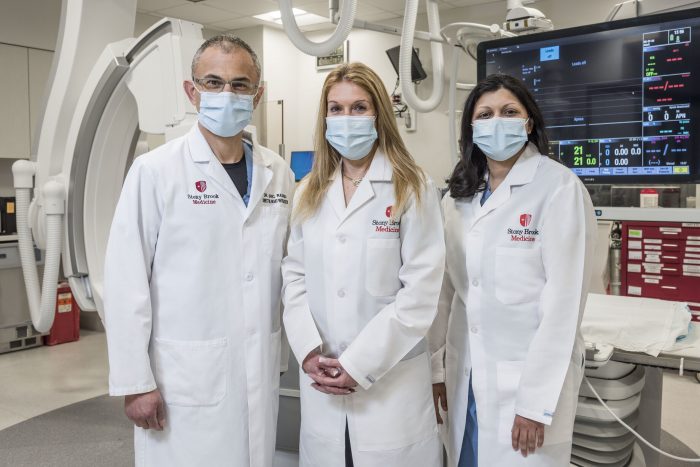
Stony Brook University Heart Institute is now offering its patients the latest generation of the Watchman FLX™ device, which provides protection from strokes for people who have atrial fibrillation (AFib), a type of arrhythmia or irregular heartbeat, that is not caused by a heart valve problem.
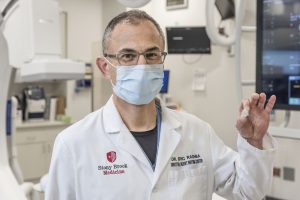
Stony Brook is one of a select number of sites in New York State to offer the new Watchman FLX device. The procedure, which closes off the part of the heart where 90% of stroke-causing clots come from, will be done in Stony Brook University Hospital’s new Advanced Multifunctional Cath/EP Lab. The large, 845-square-foot multi-functional laboratory has been carefully designed and outfitted with state-of-the-art technology to allow the Heart Institute physicians to perform a full range of procedures.
People with AFib, the most common type of heart rhythm disorder, have an increased risk of stroke by 5 times on average. Blood thinners are often prescribed to help prevent strokes but “some experience bleeding problems or have other reasons why blood thinners aren’t the best option,” explains Eric Rashba, MD, Director, Heart Rhythm Center at Stony Brook Heart Institute.
The Watchman device, which is about the size of a quarter, provides an alternative to the lifelong use of blood thinners (anticoagulants) for people with AFib by blocking blood clots from leaving the heart and possibly causing a stroke.
The design of the newer, Watchman FLX device used by the Heart Institute offers significant advantages to the patient, including:
Advanced safety due to the new framing of the device that allows for more long-term stability and a more complete seal
Enhanced procedural performance that allows the physician to better maneuver and position the device during the procedure
A broader size range to permit treatment of a wider range of patient anatomies
“At the Stony Brook Heart Rhythm Center, in the hands of our expert team, we are excited to bring this latest innovation to effectively provide protection equivalent to anticoagulants for preventing strokes and avoiding the risk of serious bleeding,” said Dr. Rashba. “It has saved lives and improved my patients’ quality of life.”
